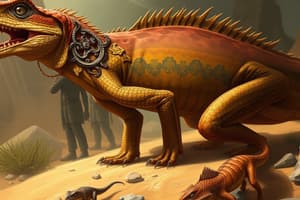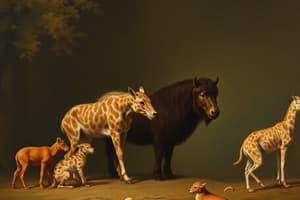Podcast
Questions and Answers
Which type of bone is primarily found in the external, dense part of bones?
Which type of bone is primarily found in the external, dense part of bones?
- Articular cartilage
- Synovial fluid
- Lamellar bone (correct)
- Cancellous bone
What is the main function of the zygapophyses in the vertebrae?
What is the main function of the zygapophyses in the vertebrae?
- To bear ribs
- To resist twisting and bending (correct)
- To allow the head to move freely
- To attach the pelvis to the vertebral column
Which layer of hypaxial muscles, present in tetrapods, helps with expelling air from the lungs?
Which layer of hypaxial muscles, present in tetrapods, helps with expelling air from the lungs?
- Costal muscles
- Transversospinalis muscles
- Transverse abdominus (correct)
- Rectus abdominus
What is the role of the rectus abdominus muscle in tetrapods?
What is the role of the rectus abdominus muscle in tetrapods?
Which of the following describes the relationship between the pectoral girdle and the vertebral column in tetrapods?
Which of the following describes the relationship between the pectoral girdle and the vertebral column in tetrapods?
What is the term for the study of the scaling relationship between the size of a body part and the overall body size?
What is the term for the study of the scaling relationship between the size of a body part and the overall body size?
What happens to the bones that connect the head to the pectoral girdle in tetrapods, compared to fish?
What happens to the bones that connect the head to the pectoral girdle in tetrapods, compared to fish?
Which of the following best describes the evolution of tetrapod limbs from fish fins?
Which of the following best describes the evolution of tetrapod limbs from fish fins?
How does the cross-sectional area of limb bones change in larger animals compared to smaller ones?
How does the cross-sectional area of limb bones change in larger animals compared to smaller ones?
What is the function of the costal muscles in the ribcage of tetrapods?
What is the function of the costal muscles in the ribcage of tetrapods?
Which muscle is primarily involved in opening the mouth in tetrapods?
Which muscle is primarily involved in opening the mouth in tetrapods?
What is the primary mechanism by which amphibians inflate their lungs?
What is the primary mechanism by which amphibians inflate their lungs?
In amniotes, what structures primarily strengthen the trachea?
In amniotes, what structures primarily strengthen the trachea?
What is the role of valves within limb veins regarding blood circulation?
What is the role of valves within limb veins regarding blood circulation?
Which animals have a heart with a fixed barrier within the ventricle?
Which animals have a heart with a fixed barrier within the ventricle?
What is the primary function of the lymphatic system?
What is the primary function of the lymphatic system?
How do terrestrial vertebrates focus their eyes?
How do terrestrial vertebrates focus their eyes?
Which structure in the middle ear receives and amplifies sound waves?
Which structure in the middle ear receives and amplifies sound waves?
What is the role of the stapes or ossicular chain in hearing?
What is the role of the stapes or ossicular chain in hearing?
In mammals, where are most olfactory receptors located?
In mammals, where are most olfactory receptors located?
What substance is produced by the outer layers of the skin in tetrapods to aid in water retention?
What substance is produced by the outer layers of the skin in tetrapods to aid in water retention?
Which of the following is a tetrapod structure involved in waste excretion?
Which of the following is a tetrapod structure involved in waste excretion?
Which of the following is a primary method of heat gain for ectotherms?
Which of the following is a primary method of heat gain for ectotherms?
What is a key advantage of endothermy?
What is a key advantage of endothermy?
Which statement best describes heat transfer through conduction?
Which statement best describes heat transfer through conduction?
What is the function of articular cartilage found in joints?
What is the function of articular cartilage found in joints?
Which of the following best describes the arrangement of bones in amniotes?
Which of the following best describes the arrangement of bones in amniotes?
What is the primary function of axial muscles in tetrapods, other than locomotion as seen in fish?
What is the primary function of axial muscles in tetrapods, other than locomotion as seen in fish?
What is the significance of the transverse abdominus muscle in some tetrapods?
What is the significance of the transverse abdominus muscle in some tetrapods?
How does the arrangement of the pectoral and pelvic girdles differ in generalized tetrapods?
How does the arrangement of the pectoral and pelvic girdles differ in generalized tetrapods?
Which of the following is a characteristic of the appendicular skeleton in early tetrapods?
Which of the following is a characteristic of the appendicular skeleton in early tetrapods?
What is the concept of allometry most directly related to?
What is the concept of allometry most directly related to?
How does the stress on bones change with animal size, according to allometry?
How does the stress on bones change with animal size, according to allometry?
What do the atlas and axis vertebrae specifically facilitate in mammals?
What do the atlas and axis vertebrae specifically facilitate in mammals?
What characteristic of limb bone do large animals generally exhibit compared to smaller animals?
What characteristic of limb bone do large animals generally exhibit compared to smaller animals?
Which muscle is responsible for swallowing food in tetrapods?
Which muscle is responsible for swallowing food in tetrapods?
What is the primary mechanism used by amniotes to draw air into their lungs?
What is the primary mechanism used by amniotes to draw air into their lungs?
What is the role of coronary arteries in the circulatory system of certain tetrapods?
What is the role of coronary arteries in the circulatory system of certain tetrapods?
What is the key function of lymph nodes within the lymphatic system?
What is the key function of lymph nodes within the lymphatic system?
How do aquatic vertebrates primarily focus their eyes?
How do aquatic vertebrates primarily focus their eyes?
What is the function of the auditory or Eustachian tube in tetrapods?
What is the function of the auditory or Eustachian tube in tetrapods?
What is the primary function of vomeronasal organs in tetrapods?
What is the primary function of vomeronasal organs in tetrapods?
What is the role of the stratum corneum in the skin of vertebrates?
What is the role of the stratum corneum in the skin of vertebrates?
Which of the following structures is a new feature in tetrapods related to waste excretion?
Which of the following structures is a new feature in tetrapods related to waste excretion?
Which of the following terms describes the metabolic generation of heat within an organism's body?
Which of the following terms describes the metabolic generation of heat within an organism's body?
How does heat transfer through the process of convection?
How does heat transfer through the process of convection?
In tetrapods, what is the primary function of the adductor mandibulae muscle?
In tetrapods, what is the primary function of the adductor mandibulae muscle?
What is the primary function of the nasolacrimal duct?
What is the primary function of the nasolacrimal duct?
Which structure in the inner ear of tetrapods contains hair cells that are stimulated by fluid waves?
Which structure in the inner ear of tetrapods contains hair cells that are stimulated by fluid waves?
What is the primary mechanism of heat loss for both ectotherms and endotherms?
What is the primary mechanism of heat loss for both ectotherms and endotherms?
What is the primary structural difference between lamellar bone and cancellous bone?
What is the primary structural difference between lamellar bone and cancellous bone?
How does the skeletal structure of tetrapods differ from that of fish concerning the connection between the head and pectoral girdle?
How does the skeletal structure of tetrapods differ from that of fish concerning the connection between the head and pectoral girdle?
What is a key function that the interlocking zygapophyses provide to the vertebral column?
What is a key function that the interlocking zygapophyses provide to the vertebral column?
How do axial muscles function differently in tetrapods compared to fish?
How do axial muscles function differently in tetrapods compared to fish?
What is the primary function of the transverse abdominus muscle in some tetrapods?
What is the primary function of the transverse abdominus muscle in some tetrapods?
How does the connection of the pectoral girdle to the vertebral column differ from that of the pelvic girdle in tetrapods?
How does the connection of the pectoral girdle to the vertebral column differ from that of the pelvic girdle in tetrapods?
What evolutionary trend is observed in the number of digits on the limbs of early tetrapods as they transitioned to land?
What evolutionary trend is observed in the number of digits on the limbs of early tetrapods as they transitioned to land?
What is the significance of the absence of a direct bony connection between the pectoral girdle and the vertebral column in tetrapods?
What is the significance of the absence of a direct bony connection between the pectoral girdle and the vertebral column in tetrapods?
How does the relative stress on bones change with increasing body size, according to allometric principles?
How does the relative stress on bones change with increasing body size, according to allometric principles?
According to allometric principles, how do the limb bones of larger animals typically differ in proportion compared to those of smaller animals?
According to allometric principles, how do the limb bones of larger animals typically differ in proportion compared to those of smaller animals?
What is the primary function of the large, muscular tongue in tetrapods?
What is the primary function of the large, muscular tongue in tetrapods?
What is the primary difference between the way amphibians and amniotes inflate their lungs?
What is the primary difference between the way amphibians and amniotes inflate their lungs?
What structural adaptation supports the trachea in amniotes, ensuring it remains open for respiration?
What structural adaptation supports the trachea in amniotes, ensuring it remains open for respiration?
What is the functional significance of valves in the limb veins of tetrapods?
What is the functional significance of valves in the limb veins of tetrapods?
Which adaptation is present in the hearts of crocodylians, birds, and mammals that optimizes the delivery of oxygenated blood to the tissues?
Which adaptation is present in the hearts of crocodylians, birds, and mammals that optimizes the delivery of oxygenated blood to the tissues?
What role do coronary arteries play in the circulatory system of some tetrapods?
What role do coronary arteries play in the circulatory system of some tetrapods?
What is the key function of lymph nodes within the lymphatic system regarding maintaining overall health?
What is the key function of lymph nodes within the lymphatic system regarding maintaining overall health?
How do terrestrial vertebrates primarily achieve focus when viewing objects at different distances?
How do terrestrial vertebrates primarily achieve focus when viewing objects at different distances?
What role does the tympanum play in the hearing process of tetrapods?
What role does the tympanum play in the hearing process of tetrapods?
How does the stapes or ossicular chain contribute to hearing in tetrapods?
How does the stapes or ossicular chain contribute to hearing in tetrapods?
Where are the majority of olfactory receptors located in mammals, enhancing their sense of smell?
Where are the majority of olfactory receptors located in mammals, enhancing their sense of smell?
What is the primary role of the stratum corneum in the skin of tetrapods for terrestrial survival?
What is the primary role of the stratum corneum in the skin of tetrapods for terrestrial survival?
Which of the following structures is a novel adaptation in tetrapods that enhances their ability to manage waste excretion effectively on land?
Which of the following structures is a novel adaptation in tetrapods that enhances their ability to manage waste excretion effectively on land?
How does heat transfer occur through convection, influencing an organism's body temperature?
How does heat transfer occur through convection, influencing an organism's body temperature?
What significant metabolic advantage do endotherms possess compared to ectotherms, affecting their activity levels and environmental range?
What significant metabolic advantage do endotherms possess compared to ectotherms, affecting their activity levels and environmental range?
Flashcards
Haversian System
Haversian System
The cylindrical structure that forms the bone in mammals, containing concentric layers of bone tissue around a central blood vessel.
Lamellar Bone
Lamellar Bone
The outer, dense layer of bone tissue.
Cancellous Bone
Cancellous Bone
The inner, spongy layer of bone tissue.
Articular Cartilage
Articular Cartilage
Signup and view all the flashcards
Synovial Fluid
Synovial Fluid
Signup and view all the flashcards
Joint Capsule
Joint Capsule
Signup and view all the flashcards
Cranial Skeleton
Cranial Skeleton
Signup and view all the flashcards
Supracleithral Bones
Supracleithral Bones
Signup and view all the flashcards
Atlas and Axis
Atlas and Axis
Signup and view all the flashcards
Allometry
Allometry
Signup and view all the flashcards
Tetrapod Tongue Function
Tetrapod Tongue Function
Signup and view all the flashcards
Muscles Involved in Feeding
Muscles Involved in Feeding
Signup and view all the flashcards
Breathing Mechanisms in Tetrapods
Breathing Mechanisms in Tetrapods
Signup and view all the flashcards
Adaptive Lung Structures in Amniotes
Adaptive Lung Structures in Amniotes
Signup and view all the flashcards
Blood Flow in Tetrapods
Blood Flow in Tetrapods
Signup and view all the flashcards
Double Circulation in Tetrapods
Double Circulation in Tetrapods
Signup and view all the flashcards
Heart Chamber Separation
Heart Chamber Separation
Signup and view all the flashcards
Ventricle Separation and Coronary Arteries
Ventricle Separation and Coronary Arteries
Signup and view all the flashcards
The Lymphatic System
The Lymphatic System
Signup and view all the flashcards
Vision in Tetrapods
Vision in Tetrapods
Signup and view all the flashcards
Eyelids, Lacrimal Glands, and Nasolacrimal Duct
Eyelids, Lacrimal Glands, and Nasolacrimal Duct
Signup and view all the flashcards
Hearing in Tetrapods
Hearing in Tetrapods
Signup and view all the flashcards
Olfactory System in Tetrapods
Olfactory System in Tetrapods
Signup and view all the flashcards
Water Conservation in Tetrapods
Water Conservation in Tetrapods
Signup and view all the flashcards
Thermoregulation in Tetrapods
Thermoregulation in Tetrapods
Signup and view all the flashcards
How do tetrapods use their tongues?
How do tetrapods use their tongues?
Signup and view all the flashcards
What muscles control the jaw and swallowing?
What muscles control the jaw and swallowing?
Signup and view all the flashcards
How do tetrapods breathe?
How do tetrapods breathe?
Signup and view all the flashcards
What are some adaptations of amniote lungs?
What are some adaptations of amniote lungs?
Signup and view all the flashcards
How is blood flow adapted for land animals?
How is blood flow adapted for land animals?
Signup and view all the flashcards
What is double circulation?
What is double circulation?
Signup and view all the flashcards
How is the tetrapod heart divided?
How is the tetrapod heart divided?
Signup and view all the flashcards
How is the ventricle of the heart separated?
How is the ventricle of the heart separated?
Signup and view all the flashcards
What is the lymphatic system?
What is the lymphatic system?
Signup and view all the flashcards
How has vision adapted for life on land?
How has vision adapted for life on land?
Signup and view all the flashcards
What are some adaptations related to vision in land vertebrates?
What are some adaptations related to vision in land vertebrates?
Signup and view all the flashcards
How does the middle ear help with hearing?
How does the middle ear help with hearing?
Signup and view all the flashcards
How are olfactory receptors organized?
How are olfactory receptors organized?
Signup and view all the flashcards
How do tetrapods conserve water?
How do tetrapods conserve water?
Signup and view all the flashcards
What is thermoregulation and how is it different in ectotherms and endotherms?
What is thermoregulation and how is it different in ectotherms and endotherms?
Signup and view all the flashcards
Zygapophyses
Zygapophyses
Signup and view all the flashcards
Sacral Vertebrae
Sacral Vertebrae
Signup and view all the flashcards
Caudal Vertebrae
Caudal Vertebrae
Signup and view all the flashcards
Axial Muscle Function
Axial Muscle Function
Signup and view all the flashcards
Transverse Abdominus
Transverse Abdominus
Signup and view all the flashcards
Rectus Abdominus
Rectus Abdominus
Signup and view all the flashcards
Costal Muscles
Costal Muscles
Signup and view all the flashcards
Transversospinalis Muscles
Transversospinalis Muscles
Signup and view all the flashcards
Reduced Ankle Bones
Reduced Ankle Bones
Signup and view all the flashcards
Limb Bone Cross-Section
Limb Bone Cross-Section
Signup and view all the flashcards
Salivary Glands
Salivary Glands
Signup and view all the flashcards
Positive Pressure Breathing
Positive Pressure Breathing
Signup and view all the flashcards
Negative Pressure Breathing
Negative Pressure Breathing
Signup and view all the flashcards
Pulmonary Circuit
Pulmonary Circuit
Signup and view all the flashcards
Systemic Circuit
Systemic Circuit
Signup and view all the flashcards
Lymphatic System
Lymphatic System
Signup and view all the flashcards
Lymph Nodes
Lymph Nodes
Signup and view all the flashcards
Terrestrial Vertebrate Vision
Terrestrial Vertebrate Vision
Signup and view all the flashcards
Aquatic Vertebrate Vision
Aquatic Vertebrate Vision
Signup and view all the flashcards
Tympanum
Tympanum
Signup and view all the flashcards
Auditory/Eustachian Tube
Auditory/Eustachian Tube
Signup and view all the flashcards
Ethmoturbinates
Ethmoturbinates
Signup and view all the flashcards
Vomeronasal Organ
Vomeronasal Organ
Signup and view all the flashcards
Stratum Corneum
Stratum Corneum
Signup and view all the flashcards
Ectothermy
Ectothermy
Signup and view all the flashcards
Study Notes
Body Support - The Skeleton
- Haversian systems are concentric layers around blood vessels in bones of amniotes.
- Lamellar bone is also known as compact bone.
- Cancellous bone is also known as spongy bone.
Body Support - Cranial Skeleton
- Eusthenopteron was a lobe-finned fish, 385 MYA, with a short snout and many bones.
- Acanthostega was an early tetrapod, 365 MYA, with a longer snout with fewer bones.
- Iguania is a modern iguana with a long snout with few bones.
Body Support - Vertebrae and Ribs
- Cervical, thoracic, lumbar, sacrum and caudal relate to the spine.
Body Support - Axial Muscles
- Vertebrate Life 10e, and Figure 12.3 are relevant to axial muscles.
Body Support - Appendicular Skeleton
- Figure 12.5 depicts the tetrapod appendicular skeleton.
Body Support - Appendicular Skeleton: Limbs & Limb Girdles
- Humerus connects to the radius and ulna in the forelimb, and the tibia and fibula in the hindlimb.
- Ankle was originally many small bones arranged in two rows that have gradually fallen away.
- Early terrestrial walkers had eight digits on each limb.
- VERTEBRATE LIFE 10e, Figure 12.4 relates to the discussion of limbs and the limb girdles.
Eating
- Shutterstock.com is a relevant source.
Breathing
- Figure 12.7 relates to breathing mechanics
Pumping Blood
- Figure 12.9 shows circulatory system and blood flow
Sensory Systems - Vision
- Figure 12.12 relates to Fish and Terrestrial Vertebrate Vision
Sensory Systems - Hearing
- Figures 12.13 relates to Hearing
- Sauropsids have a stapes
- Synapsids have Malleus, Incus and Stapes
Sensory Systems - Olfaction
- Figure 12.14 relates to Olfaction
Controlling Body Temperature
- Thermoregulation is essential for tetrapods.
- Figure 12.15 has relevant information.
- Heat is gained and lost through the body.
Ectothermy
- Involves radiant temperature with the sun as primary heat source.
- Infrared Radiation is emitted by all animate and inanimate objects according to their surface temperature.
- Convection transfers heat between an animal and a fluid like air.
- Conduction allows heat to be transferred between a body and a substrate
- Heat can be lost through evaporation.
- Ancestral Form is relevant
- Metabolic heat gain is comparatively low in ectotherms
Endothermy
- Animals exchange energy with the environment in the same ways as ectotherms
- Have a 7-10x higher metabolism than ectotherms
- During cellular metabolism, chemical bonDs are broken
- Some of the energy is lost as heat, which is used to maintain body temperature
- Ask, "What are some of the advantages of endothermy? Why would that strategy have evolved?"
Heterothermy
- Euthermia relates to heterothermia with the Onset of a torpor and arousal from a torpor.
Studying That Suits You
Use AI to generate personalized quizzes and flashcards to suit your learning preferences.




